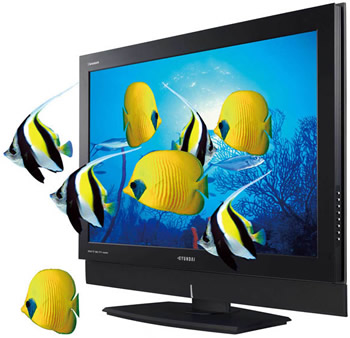Monday, October 18, 2010
What To Make of a 3D Future
I was still in Elementary School when my brother came home with Nintendo's new system: the Virtual Boy. As both of us were kids and no amount of dishes we washed could earn us enough to buy a system with a $200 (U.S.) price tag, my brother, genius as he was, was the first kid out of the school doors that day when it was released to at least rent the system. Dubbed as the first "Home 3-D Virtual Reality Experience," players would put their faces into a pair of giant red goggles perched upon a stand, playing games completely coloured in red and black. Besides the obvious problems of having one's face literally directly in the screen forced to see only red lines flying by for however long one decided to play, as an excited naive child, I could look past these problems. What I could not look past, however, was the fact that not only could I not play any game concurrently with my older brother, but more disappointingly for a younger sibling was that I could not see what my big brother was doing while he was playing. The screen was completely blocked from my view, as was the poor design of the system. The Virtual Boy was Nintendo's biggest failure and you'd be hard pressed seeing anyone owning one today, let alone speaking of it, unless they were a collector.
Today, the pursuit of 3-D has enjoyed a sudden resurgence, this time in film and television.
RealD, the leading global licensor of 3D technologies, really put 3D back into mainstream movie theatres in 2009 with major releases such as Coraline, Monsters vs. Aliens, and the Academy Award Winning UP. Audiences showing up would be handed RealD sunglasses upon entering the movies in order to enjoy the 3D viewing. Right away, audiences were captivated by this wonderful technology, with curious viewers often tilting their glasses down to see what the screen would look like without their new eyewear and being treated to a blurrier version of the movie. That being said, people loved the new 3D, but do they love it enough for it to stick around?
In order to truly captivate audiences, 3D is not the sole answer for movie-goers. Movies need a good story, beautiful cinematography, and convincing acting. Sometimes 3D detracts from the movie experience because the new technology amazes us in itself and makes us aware of the 3D atmosphere. When the technology pulls us out of the film and makes us aware of the fact that we are in a movie theatre, our suspension of disbelief is lost as a result. As we grow more accustomed to seeing 3D movies, will we be immersed further in the movie or will we be merely distracted? More importantly, when the gimmick feeling is gone, will audiences be willing to pay a few dollars extra for the same movie in 3D? Going to the movie theatre is expensive enough as is, and families might be more prone to saving a few dollars per ticket by enjoying films in regular 2D. In the meantime, people were forking out the extra dollar or two for the new viewing experience, and businesses figured they could do the same for TV at home.
This past summer, major television companies, such as Sony and Samsung, led the way in what hopes to be a promising home 3D market. With 3DTV options currently being primarily within sports programming, the debut for home viewers came in the form of this past summer's World Cup of Soccer. Most consumers have the opportunity to experience a glimpse of 3DTV in a nearby electronics retailer, but once the initial "Hey.. this is kinda cool" feeling is gone, are the pros of 3DTV enough to outweigh its several cons? Sports programming remains largely the same despite the addition of more cameras and improved presentation. Most sports rules remain unchanged, so the product needs some innovation for the TV audiences if it is to progress. High Definition TV has done wonders for sports fans, viewers often amazed by the sweat beads they can now see on their beloved athletes, but is 3D really the next step for the masses? It doesn't sound very convenient to have a bunch of guys sitting around wearing glasses in order to enjoy TV. Imagine having a big party for the Super Bowl: Do friends have to bring over their own 3D glasses from home if the host doesn't have enough? Will we be forced to continually take our glasses on and off as we go back and forth from the TV, to the kitchen, back to the TV, to the bathroom, back to the TV? It also sounds inconvenient that people in the family walking by will not be able to see the TV clearly without going to the drawer to pull out another pair of 3D glasses in attempts of catching a highlight or two.
In order to prevent this inconvenience, Toshiba is currently working on a 3DTV that does not require special glasses. However, in order to fully enjoy the programs, the TV's are "best when viewed from within a 40-degree zone of center." (1) Imagine cramming all your friends directly in front of the TV because it cannot accommodate an off-centre view.
As I enjoy the marvels of 3D movie masterpieces, such as Inception or Avatar, I see 3DTV as the next step in home entertainment technology. Other times, though, I wonder if 3DTV is much like playing Nintendo's Virtual Boy all those years ago: exclusionary, when all I really want is to enjoy it and share in it with those around me.
aa.
1 http://www.nytimes.com/2010/10/05/technology/05toshiba.html?_r=1&scp=1&sq=3-D%20TV&st=cse
Labels:
Television
Subscribe to:
Post Comments (Atom)



No comments:
Post a Comment